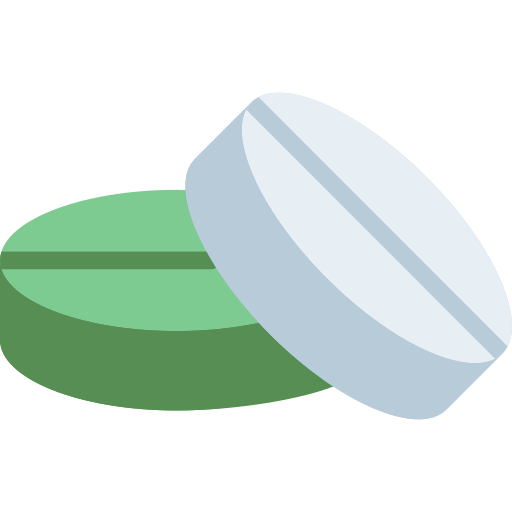
Pirfenidone
534 mg
Beacon Pharmaceuticals Ltd.
Product Details
Description
Pirfenidone is a novel agent with anti-inflammatory, antioxidant, and anti-fibrotic properties. It may improve lung function and reduce the number of acute exacerbations in patients with idiopathic pulmonary fibrosis (IPF). The precise mechanism of action of pirfenidone and its specific molecular targets have yet to be elucidated. One vital anti-fibrotic mechanism involves the suppression of TGF-β1 (transforming growth factor-β1), a key cytokine involved in fibrogenesis and extracellular matrix production. There is also evidence to suggest that pirfenidone has the ability to downregulate the expression of potent pro-inflammatory cytokines including TNF-α, interleukin-1, and interferon-gamma. In animal models, pirfenidone can inhibit both the influx of inflammatory cells and the increased pulmonary vascular permeability induced by bleomycin.
With medicine: Moderate (e.g., ciprofloxacin) and strong inhibitors of CYP1A2 (e.g., fluvoxamine) increase the systemic exposure of Pirfenidone and may alter the adverse reaction profile of Pirfenidone. Discontinue fluvoxamine prior to administration of Pirfenidone or reduce to 267 mg three times a day. Consider dosage reduction with use of ciprofloxacin. With food and others: None. A reduced incidence of adverse reactions was observed in the fed group when compared to the fasted group.
Hypersensitivity to the active substance or to any of the excipients, concomitant use of fluvoxamine, severe hepatic impairment or end stage liver disease, severe renal impairment (CrCl <30 ml/min) or end stage renal disease requiring dialysis.
Common: nausea, rash, abdominal pain, upper respiratory tract infection, diarrhea, fatigue, headache, dyspepsia, dizziness, vomiting, anorexia, gastroesophageal reflux disease, sinusitis, insomnia, weight decrease, and arthralgia. Rare: photosensitivity reaction, decreased appetite, pruritus, asthenia, dysgeusia, and non-cardiac chest pain.
Pregnancy: There are no data from the use of Pirfenidone in pregnant women. In animals’ placental transfer of pirfenidone and/or its metabolites occurs with the potential for accumulation of pirfenidone and/or its metabolites in amniotic fluid. At high doses (1000 mg/kg/day) rats exhibited prolongation of gestation and reduction in fetal viability. As a precautionary measure, it is preferable to avoid the use of Pirfenidone during pregnancy. Lactation: It is unknown whether pirfenidone or its metabolites are excreted in human milk. Available pharmacokinetic data in animals have shown excretion of pirfenidone and/or its metabolites in milk with the potential for accumulation of pirfenidone and/or its metabolites in milk. A risk to the suckling child cannot be excluded. A decision must be made whether to discontinue breast-feeding or to discontinue from Pirfenidone therapy, taking into account the benefit of breast-feeding for the child and the benefit of Pirfenidone therapy for the mother. Fertility: Pirfenidone had no effects on fertility and reproductive performance in rats at dosages up to 1000 mg/kg/day (approximately 3 times the MRDD in adults on mg/m2 basis)
Elevated liver enzymes: ALT, AST, and bilirubin elevations have occurred with Pirfenidone. Monitor ALT, AST, and bilirubin before and during treatment. Temporary dosage reductions or discontinuations may be required. Photosensitivity and rash: Photosensitivity and rash have been noted with Pirfenidone. Avoid exposure to sunlight and sunlamps. Wear sunscreen and protective clothing daily. Temporary dosage reductions or discontinuations may be required. Gastrointestinal disorders: Nausea, vomiting, diarrhea, dyspepsia, gastroesophageal reflux disease, and abdominal pain have occurred with Pirfenidone. Temporary dosage reductions or discontinuations may be required.
Use in Children & Adolescents: It is not known if Pirfenidone is safe and effective in children & adolescents. Hepatic Impairment: Monitor for adverse reactions and consider dosage modification or discontinuation of Pirfenidone as needed. Pirfenidone is not recommended for use in patients with severe hepatic impairment. Renal Impairment: Monitor for adverse reactions and consider dosage modification or discontinuation of Pirfenidone as needed. Pirfenidone is not recommended for use in patients with end-stage renal disease on dialysis. Smokers: Decreased exposure has been noted in smokers which may alter the efficacy profile of Pirfenidone.
There is limited clinical experience with overdose. Multiple doses of pirfenidone up to a dose of 4806 mg/day were administered as six 267 mg tablets three times daily to healthy adult volunteers over a 12-day dose escalation period. Adverse reactions were mild, transient, and consistent with the most frequently reported adverse reactions for pirfenidone.
-
Support 24/7
Call us anytime -
100% Safety
Only secure payments